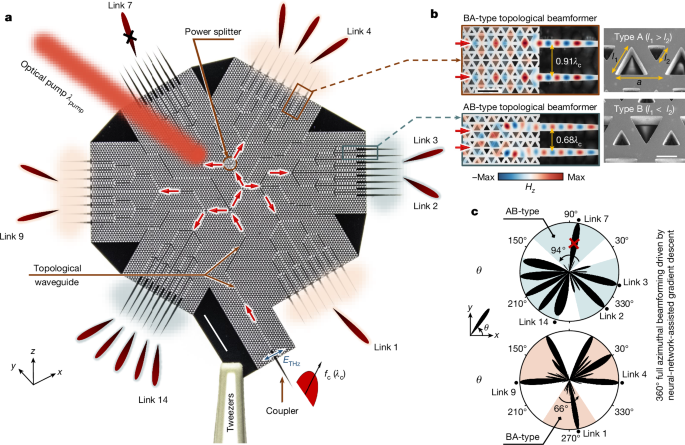Efficient On-Chip Topological Beamformer for High-Speed Multi-Link Terahertz 6G to XG Wireless Communication
Core Concepts
An on-chip broadband terahertz topological beamformer using valley vortices enables efficient, reconfigurable, and high-capacity wireless communication for future 6G to XG networks.
Abstract
The content presents an innovative on-chip topological beamformer for terahertz (THz) wireless communication, which is crucial for enabling high-capacity, low-latency, and extensive connectivity in future 6G to XG networks.
Key highlights:
- The beamformer leverages valley vortices for waveguiding, splitting, and isolation in a densely packed waveguide phased array, achieving complete 360° azimuthal beamforming with gains up to 20 dBi.
- Using neural-network-assisted inverse design, the beamformer can radiate THz signals into free space with customizable user-defined beams.
- Photoexcitation enables reconfigurable control of the THz beams, allowing for dynamic beam steering and adaptation.
- The low-loss and broadband beamformer enables a 72-Gbps chip-to-chip wireless link over 300 mm and eight simultaneous 40-Gbps wireless links, demonstrating its potential for terabit-per-second 6G to XG wireless communications.
- The all-silicon beamformer is CMOS-compatible, enabling large-scale integration and deployment for massive SIMO and MIMO systems.
Customize Summary
Rewrite with AI
Generate Citations
Translate Source
To Another Language
Generate MindMap
from source content
Visit Source
www.nature.com
On-chip topological beamformer for multi-link terahertz 6G to XG wireless - Nature
Stats
The beamformer achieves a gain of up to 20 dBi.
The beamformer enables a 72-Gbps chip-to-chip wireless link over 300 mm and eight simultaneous 40-Gbps wireless links.
Quotes
"Leveraging neural-network-assisted inverse design, the beamformer achieves complete 360° azimuthal beamforming with gains of up to 20 dBi, radiating THz signals into free space with customizable user-defined beams."
"Photoexciting the all-silicon beamformer enables reconfigurable control of THz beams."
Key Insights Distilled From
by Wenhao Wang,... at www.nature.com 08-14-2024
https://www.nature.com/articles/s41586-024-07759-5
Deeper Inquiries
How can the reconfigurable beam steering and adaptation capabilities of the topological beamformer be leveraged to enhance the reliability and resilience of 6G to XG wireless networks?
The reconfigurable beam steering and adaptation capabilities of the topological beamformer can significantly enhance the reliability and resilience of 6G to XG wireless networks in several ways. Firstly, by dynamically adjusting the beamforming direction based on environmental conditions and network traffic, the beamformer can optimize signal strength and quality, mitigating interference and improving overall network performance. This adaptability is crucial in scenarios where obstacles or signal blockages may occur, ensuring continuous connectivity and seamless data transmission. Additionally, the ability to steer beams in real-time enables rapid response to changing network conditions, such as signal fading or channel variations, enhancing the robustness of the wireless link. Moreover, the beamformer's reconfigurability allows for adaptive beamforming strategies, such as beam hopping or null steering, to counteract interference sources and maintain reliable communication links in challenging environments. Overall, leveraging these capabilities can lead to more resilient and reliable 6G to XG wireless networks that can adapt to dynamic operating conditions and deliver consistent high-performance connectivity.
What are the potential challenges and trade-offs in scaling up the topological beamformer technology for large-scale deployment in real-world 6G to XG wireless systems?
Scaling up the topological beamformer technology for large-scale deployment in real-world 6G to XG wireless systems presents several challenges and trade-offs that need to be carefully considered. One major challenge is the complexity of integrating a large number of valley-locked waveguides, power splitters, and sharp bends on a single chip, which can increase fabrication costs and introduce manufacturing variability. Ensuring uniform performance across all components and maintaining precise control over beamforming characteristics becomes more challenging as the scale of the beamformer increases. Additionally, the power consumption of the beamformer may escalate with the addition of more components, impacting energy efficiency and thermal management in the system. Trade-offs between beamformer size, power consumption, and performance metrics such as gain and bandwidth need to be carefully balanced to meet the requirements of real-world 6G to XG wireless systems. Furthermore, the scalability of the beamformer architecture in terms of supporting multiple simultaneous wireless links and accommodating diverse user scenarios without compromising performance poses a significant design challenge. Addressing these challenges and trade-offs is essential to ensure the successful large-scale deployment of the topological beamformer technology in next-generation wireless networks.
Given the high-speed wireless communication capabilities demonstrated, how might this technology enable new applications and use cases beyond traditional telecommunications, such as in the fields of extended reality, industrial automation, or remote healthcare?
The high-speed wireless communication capabilities demonstrated by the topological beamformer technology open up a wide range of new applications and use cases beyond traditional telecommunications, particularly in fields such as extended reality, industrial automation, and remote healthcare. In extended reality (XR) applications, such as virtual reality (VR) and augmented reality (AR), the ultra-high data rates and low latency provided by the beamformer can support immersive experiences with seamless real-time interaction and content delivery. Industrial automation systems can benefit from the beamformer's ability to enable high-speed wireless connectivity for smart factories, enabling real-time monitoring, control, and coordination of industrial processes. The low-latency and high-bandwidth communication facilitated by the beamformer can enhance the efficiency and responsiveness of automated systems, leading to improved productivity and operational performance. In remote healthcare applications, the technology can enable high-resolution video streaming, remote diagnostics, and telemedicine services with minimal delay, facilitating remote patient monitoring, consultation, and treatment. The reliability and speed of wireless communication offered by the beamformer can revolutionize healthcare delivery by enabling remote access to medical expertise and resources, particularly in underserved or remote areas. Overall, the technology's high-speed wireless communication capabilities unlock a myriad of innovative applications and use cases across various industries, paving the way for transformative advancements in extended reality, industrial automation, remote healthcare, and beyond.
0
